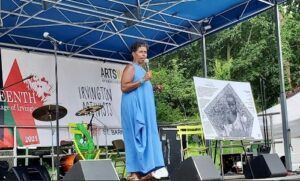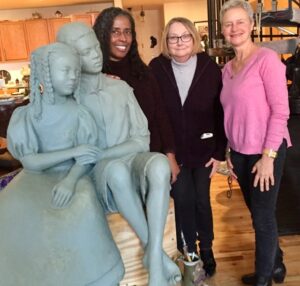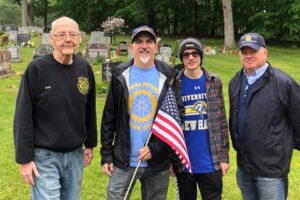
Who created our beautiful River Towns, and laid the foundations of our communities?
The answers to these questions can be heavily Euro-centric, but if so they overlook a crucial component – the vital contribution made by enslaved people locally. In 1723, Westchester’s enslaved population was 448. By 1771, the number had jumped to 3,430 – outnumbering those enslaved (and some free) in Manhattan. The relative height of slavery in Westchester was 1756, with Black people representing 15.7% of the population.

In Irvington, the dedicated work of Commemorate, a group formed in 2018, has established a model of how to reveal and honor the input of this silent, often nameless local work force who historians say cleared the land, built the dwellings, cultivated the crops, tended the livestock, and enriched the tenant farmers. By examining estate inventories, court records, wills and other historical documents, two Commemorate members – co-chair Sarah Cox, an educator at Philipsburg Manor, and fellow co-chair, journalist Cathy Sears – have excavated the range of roles and in some cases even the names of some of Irvington’s enslaved men, women and children. They have also uncovered more definitive proof of an enslaved African burial ground in the village and its location. And in order to give lasting prominence to this history, Commemorate is committed to placing a permanent piece of art where it can’t be overlooked.
“We wanted a statue from the beginning, in the form of public art, something on Main Street,” said Cox. And the choice of artist was not difficult after Commemorate members attended the unveiling of Vinnie Bagwell’s five planned sculptures for the Enslaved Africansʼ Rain Garden in Yonkers. Bagwell was born in Yonkers, grew up in Greenburgh and is credited with reframing public art to include historic Black images. “She is so well known – it was an amazing coup, to get such a renowned artist,” says Cox. Most importantly, the statue Bagwell has been commissioned to create will pay tribute to enslaved people who would not have had a likeness made of them.
Titled “Yesterday,” the bas-relief sculpture depicts a young –approximately six-year-old– enslaved girl. “In the early, early days, most of the enslaved were very young people,” Bagwell commented. “I wanted to remind people that children were enslaved too and sensitize the school children about people their age who were enslaved for life.” She continued: “I want people of every ethnicity to see the work. It’s about human relations.” The sculpture will be unveiled during Irvington’s third annual Juneteenth celebration, on Saturday, June 18, from 2-5 at Main Street School in Irvington.
While nearby Philipsburg Manor has long taught its visitors about the 23 enslaved Africans who lived at the Upper Mills in 1750, it would be interesting to see other towns and villages in our area undergoing similar projects to reintroduce New York’s history of slavery. Paul Feiner, Greenburgh town supervisor, has commented: “The town is in the process of turning the Odell House on Ridge Road in Hartsdale into a museum. That house played an important role in winning the Revolutionary War (Rochambeau and George Washington made some strategic decisions there that won the war). When we create the museum we would like to highlight the fact that slavery existed in this area. In fact the Odells may have had slaves. I would love to find out if there was an underground railroad.
“Greenburgh is one of the more progressive communities in Westchester,” Feiner said. “It’s hard to believe that those who lived in our community in the past treated other human beings so poorly. I am pleased that Irvington has decided to honor the memories of slaves who helped build Irvington. They should be remembered for their contributions.”
Ossining Village Historian Joyce Cole has also discovered the names of the formerly enslaved of the area and her findings will be a part of the Black History Month Exhibit at Bethany Arts Community (Feb. 4 to March 12). Regarding Commemorate’s work, she said: “I am most impressed as a genealogist, who knows the amount of work it takes to conduct research of formerly enslaved Africans. Their dedication to unearthing, sharing and memorializing the lives of these forgotten people is heartwarming, admirable, and necessary. … Acknowledgement of this part of our history, saying the names of the forgotten enslaved and ensuring their story is told as part of the American story is a great step towards a more equitable future.”
For more information, visit irvingtonhistoricalsociety.org.






